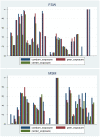Community-based prevention leads to an increase in condom use and a reduction in sexually transmitted infections (STIs) among men who have sex with men (MSM) and female sex workers (FSW): the Frontiers Prevention Project (FPP) evaluation results
- PMID: 20718977
- PMCID: PMC2940912
- DOI: 10.1186/1471-2458-10-497
Community-based prevention leads to an increase in condom use and a reduction in sexually transmitted infections (STIs) among men who have sex with men (MSM) and female sex workers (FSW): the Frontiers Prevention Project (FPP) evaluation results
Abstract
Background: India has an estimated 2.0 million to 3.1 million people living with HIV; it has the highest number of HIV-positive people in Asia and ranks third in the world. The Frontiers Prevention Project (FPP) was implemented in 2002 to conduct targeted prevention intervention geared towards female sex workers (FSW) and men who have sex with men (MSM) in the state of Andhra Pradesh (AP). This paper reports the overall changes in behaviour and STI outcomes between 2003/4 and 2007 and also describes the changes attributed to the FPP.
Methods: The evaluation used two cross-sectional surveys among MSM and FSW at 24 sites in AP. Surveys were implemented using a similar methodology. Univariate analyses were conducted by comparing means: baseline vs. four-year follow-up and FPP vs. non-FPP. For both MSM and FSW, random and fixed-effects logit regression models at the site level were estimated for condom use with last partner, syphilis sero-positivity and HSV 2 sero-positivity. In addition, for FSW we estimated models for condom use with regular partner, and for MSM we estimated models for condom use with last female partner.
Results: Among MSM, fixed-effects analysis revealed that FPP was positively correlated with the probability of condom use with last female sexual partner and negatively correlated with the individual probability of sero-positivity to syphilis and HSV 2. Among FSW, the FPP intervention was significantly correlated with increased condom use with regular partners and with lower probability of STI sero-positivity.
Discussion: Important changes in behaviours related to an increase in prevention activities translated to reductions in STI sero-prevalence in AP, India. In contrast with non-FPP sites, the FPP sites experienced an intense community approach as part of the FPP intervention, and the general increase in condom use and its effect on STI sero-prevalence reflected the efficacy of these intense prevention activities focused on key populations in AP.
Figures



Similar articles
-
Condom use and prevalence of syphilis and HIV among female sex workers in Andhra Pradesh, India - following a large-scale HIV prevention intervention.BMC Public Health. 2011 Dec 29;11 Suppl 6(Suppl 6):S1. doi: 10.1186/1471-2458-11-S6-S1. BMC Public Health. 2011. PMID: 22376071 Free PMC article.
-
Increase in condom use and decline in prevalence of sexually transmitted infections among high-risk men who have sex with men and transgender persons in Maharashtra, India: Avahan, the India AIDS Initiative.BMC Public Health. 2014 Aug 3;14:784. doi: 10.1186/1471-2458-14-784. BMC Public Health. 2014. PMID: 25086742 Free PMC article.
-
Increasing condom use and declining STI prevalence in high-risk MSM and TGs: evaluation of a large-scale prevention program in Tamil Nadu, India.BMC Public Health. 2013 Sep 17;13:857. doi: 10.1186/1471-2458-13-857. BMC Public Health. 2013. PMID: 24044766 Free PMC article.
-
Why do men who have sex with men practice condomless sex? A systematic review and meta-synthesis.BMC Infect Dis. 2022 Nov 14;22(1):850. doi: 10.1186/s12879-022-07843-z. BMC Infect Dis. 2022. PMID: 36376835 Free PMC article.
-
Are psychosocial interventions effective at increasing condom use among Black men? A systematic review.Int J STD AIDS. 2021 Oct;32(12):1088-1105. doi: 10.1177/09564624211024785. Epub 2021 Jun 18. Int J STD AIDS. 2021. PMID: 34144658 Free PMC article.
Cited by
-
Condom use and prevalence of syphilis and HIV among female sex workers in Andhra Pradesh, India - following a large-scale HIV prevention intervention.BMC Public Health. 2011 Dec 29;11 Suppl 6(Suppl 6):S1. doi: 10.1186/1471-2458-11-S6-S1. BMC Public Health. 2011. PMID: 22376071 Free PMC article.
-
Field-based video pre-test counseling, oral testing, and telephonic post-test counseling: implementation of an HIV field testing package among high-risk Indian men.AIDS Educ Prev. 2012 Aug;24(4):309-26. doi: 10.1521/aeap.2012.24.4.309. AIDS Educ Prev. 2012. PMID: 22827901 Free PMC article.
-
Public health interventions to control syphilis.Sex Health. 2015 Apr;12(2):126-34. doi: 10.1071/SH14156. Sex Health. 2015. PMID: 25588031 Free PMC article.
-
Ensuring it works: a community-based approach to HIV prevention intervention development for men who have sex with men in Chennai, India.AIDS Educ Prev. 2012 Dec;24(6):483-99. doi: 10.1521/aeap.2012.24.6.483. AIDS Educ Prev. 2012. PMID: 23206199 Free PMC article.
-
Implementation practice models for development in low- and middle-income countries: systematic review of peer-reviewed literature.BMC Public Health. 2022 Jun 9;22(1):1157. doi: 10.1186/s12889-022-13530-0. BMC Public Health. 2022. PMID: 35681165 Free PMC article.
References
-
- UNAIDS. 2.5 million people in India living with HIV, according to new estimates. 2007. http://data.unaids.org/pub/PressRelease/2007/070706_indiapressrelease_en... cited 2009 September 18, 2009.
-
- APSACS. Facts, figures and response to HIV/AIDS in Andhra Pradesh.Hyderabad: Andhra Pradesh State AIDS Control Society. 2005.
-
- International-HIV/AIDS-Alliance, ASCI, NIMS, INSP. Key indicators for Frontiers Prevention Project: Report on baseline study in Andhra Pradesh, India. Brighton, UK: International-HIV/AIDS-Alliance; 2006.

